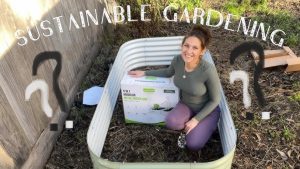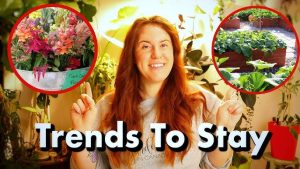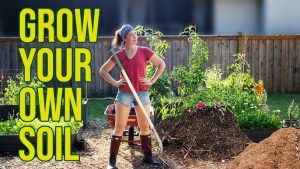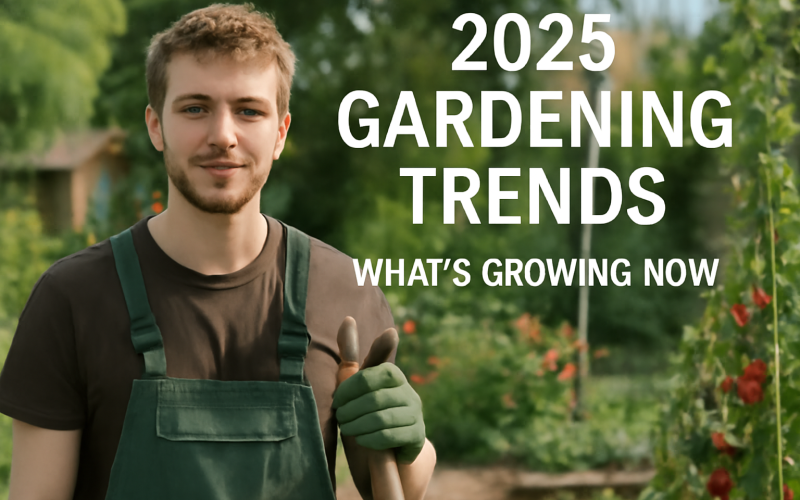Introduction
Gardening is experiencing a revolution in 2025, with new trends reshaping how we grow plants, manage our gardens, and interact with the environment. People are becoming more conscious about the planet, and gardening is evolving to meet these needs. Whether you’re an experienced gardener or just starting out, this year’s gardening trends offer exciting ways to make your home garden more beautiful, sustainable, and innovative.
From eco-friendly gardening techniques to the rise of indoor plants, 2025 is the year of growth and change in the gardening world. In this article, we’ll explore the top gardening trends for 2025, highlight planting ideas, and provide some useful tips for gardeners of all experience levels. Let’s dive into the future of gardening!
What is Sustainable Gardening?

Sustainable gardening focuses on long term practices that help conserve resources, reduce waste, and protect the environment. It involves using eco-friendly gardening methods such as composting, planting native species, and reducing the use of chemicals. With climate change becoming an increasing concern, gardeners are turning to these practices to create more resilient and eco-friendly gardens.
In 2025, sustainable gardening is becoming more mainstream, with many gardeners adopting these methods to help the planet. The emphasis is not just on aesthetics but also on green gardening practices that improve the health of the environment.
The Top 2025 Gardening Trends

1. Sustainable and Eco-Friendly Gardening
Sustainability is at the heart of many gardening trends in 2025. People are looking for ways to make their gardens more eco-friendly. This means using less water, reducing waste, and supporting biodiversity. Gardeners are now choosing plants that are suited to their local environment and that need fewer resources to thrive.
For example, many are turning to native plants that require less water and are better for the local ecosystem. Composting is also growing in popularity, allowing gardeners to recycle organic waste and create nutrient-rich soil for their plants.
Tips for Sustainable Gardening:
- Use native plants that are well-suited to your climate.
- Start a compost bin to recycle kitchen waste and create healthy soil.
- Avoid pesticides and use natural alternatives to keep plants healthy.
2. Vertical and Urban Gardening
As cities grow and space becomes more limited, urban gardening is becoming a popular trend. Vertical gardening allows people to grow plants on walls, fences, and even in small indoor spaces. It’s perfect for apartment dwellers and those with limited outdoor space.
Indoor plants are also a big part of this trend, with many homeowners and city dwellers bringing nature indoors. Plants like succulents, herbs, and houseplants are easy to care for and can improve indoor air quality. Vertical gardens can be made using planters, trellises, or specially designed wall planters.
Tips for Vertical and Urban Gardening:
- Use hanging baskets or wall-mounted planters to maximize space.
- Grow herbs indoors near windows to have fresh ingredients on hand.
- Invest in vertical garden systems for a stylish way to grow plants at home.
3. Indoor Plants and Green Interiors
In 2025, indoor plants are more popular than ever. People are adding plants to their homes to improve air quality and bring nature indoors. Houseplants such as snake plants, succulents, and peace lilies are common choices for home decor.
Many people are creating green interiors by adding plants to their living spaces, including offices, bedrooms, and even bathrooms. Not only do indoor plants make a room look more beautiful, but they also provide health benefits, like improved air quality and increased humidity.
Tips for Indoor Plants:
- Choose plants that are easy to care for, like snake plants or spider plants.
- Use stylish planters that complement your home decor.
- Place plants in areas with adequate light and water them regularly.
4. Edible Gardens and Homegrown Food
As more people become interested in self-sufficiency, edible gardens are on the rise. Growing your own food not only saves money, but it also reduces your carbon footprint and improves your overall health. In 2025, people are planting vegetable gardens, fruit trees, and herbs in their backyards, balconies, and even indoors.
Gardening for food is becoming a part of everyday life. Whether you have a small apartment or a large backyard, you can grow a variety of edible plants, such as tomatoes, lettuce, herbs, and peppers.
Tips for Edible Gardens:
- Start with easy-to-grow vegetables like lettuce or tomatoes.
- Use compost to enrich the soil and improve plant growth.
- Grow herbs indoors on your windowsill for easy access to fresh ingredients.
5. Natural and Non-Toxic Gardening
Another important trend for 2025 is the shift toward non-toxic gardening. Many gardeners are choosing to dust mites, avoid harmful chemicals and instead focus on natural pest control and organic methods. Using natural alternatives to pesticides and fertilizers ensures a safer environment for pollinators like bees and butterflies.
Natural gardening methods, such as using companion plants and introducing beneficial insects, are becoming more popular. Many people are also creating wildlife-friendly gardens that attract birds, insects, and other animals.
Tips for Non-Toxic Gardening:
- Use companion planting to naturally repel pests.
- Grow plants like marigolds or lavender to attract beneficial insects.
- Avoid chemical pesticides and choose natural alternatives like neem oil.
6. Smart Gardening Technology
In 2025, smart gardening technology is transforming how we care for our plants. From smart irrigation systems to plant sensors, technology is making it easier to monitor and care for plants, especially for those who may not have a green thumb.
For example, smart irrigation systems automatically water your plants based on soil moisture levels, helping to conserve water. Plant sensors can alert you when your plants need attention, making it easier to keep them healthy.
Tips for Using Smart Gardening Technology:
- Invest in a smart watering system to reduce water waste.
- Use plant sensors to monitor soil moisture and sunlight.
- Try automated indoor grow lights to help plants grow in low-light areas.
The Future of 2025 Gardening Trends

The future of gardening in 2025 looks promising as more people embrace green living and sustainable practices. We can expect to see innovations in gardening tools, technology, and even plants that make it easier for everyone to get involved, no matter their experience level. Vertical gardens and hydroponics will likely become more popular, especially in urban areas. Technology, like smart gardening systems that help manage water and sunlight, will make gardening more efficient and accessible. The future of gardening will continue to be shaped by a desire to live sustainably, grow our own food, and create beautiful, healthy spaces for everyone to enjoy.
Comparative Table: Popular Gardening Trends in 2025
| Trend | Description | Example Products/Plants |
|---|---|---|
| Sustainable Gardening | Focus on eco-friendly, resource-saving practices | Native plants, compost bins |
| Vertical & Urban Gardening | Growing plants in small, limited spaces | Vertical garden systems, herbs |
| Indoor Plants | Bringing nature indoors for better air and aesthetics | Snake plants, succulents, pothos |
| Edible Gardens | Growing your own food in small spaces | Tomatoes, lettuce, peppers |
| Natural & Non-Toxic Gardening | Avoiding chemicals and using natural methods | Neem oil, companion plants |
| Smart Gardening Technology | Using tech to make gardening easier and more efficient | Smart irrigation, plant sensors |
Conclusion
2025 gardening trends show that people are becoming more aware of the environment and looking for ways to make their gardens greener and more sustainable. Whether it’s through sustainable gardening, vertical gardening, or using smart technology, there are plenty of ways to make your garden thrive in an eco-friendly way.
These trends are helping to create a greener, more sustainable world, one garden at a time. By adopting these gardening innovations, you can contribute to a healthier planet while enjoying the benefits of a beautiful and thriving garden.
Call-to-Action:
Ready to start your own eco-friendly garden? Explore our website for more gardening tips, sustainable products, and tools that can help you grow a greener, healthier space in your home!












